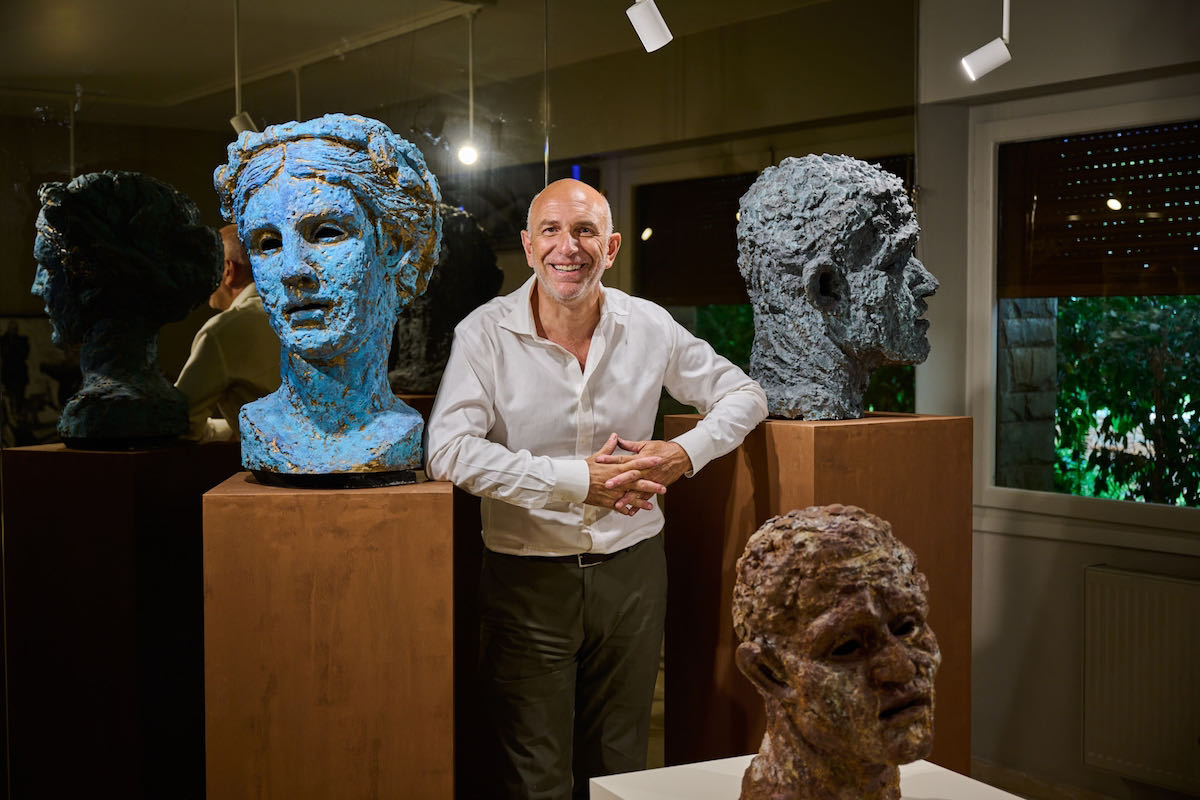
The muse of classic sculpture at the Greek Consulate in New York seems to be working in unison with George Petrides' work uptown
Classical sculpture through the lens of sculptor George Petrides establishes a new vision in form and figure through juxtaposition of shape in a colorful palette. These sculptures are on view at the Consulate of Greece at 69 East 79th Street, New York, NY 10075 until February 3rd, 2022, weekdays from 9-2:30 pm. This show, which he shares with abstract painter Nassos Daphnis, is just the tip of his prolific artistic iceberg of work. He has been working on larger figures and the Hellenic Heads that are not part of this show but will be on view very soon. I’ve included photos of these pieces as well as his work in the current exhibition which presents tabletop size figures. In the installation, the figures quietly greet the audience in a half circle. The figures do not look at us. Their eyes are cast down. This had me recall a quote from Jean Genet speaking about the sculptural work of Giacometti "Figures they are familiar,… and yet they come from the depths of time, the origin of all things. In their sovereign immobility, they ceaselessly approach, but they do not look at us but allow us to gaze upon them."
In addition to being an incredibly visual storyteller, Petrides proves to be as good with words. I had the chance to talk with him at length and have enclosed sections of our discussion.
The muse of classic sculpture at the Greek Consulate seems like Kismet for your work. Can you talk about how the show came about?
The Greek Consulate in New York runs a wonderful arts exhibition program, where Greek and Greek-American artists show work in attractive rooms on the first floor and lower level of their gorgeous townhouse headquarters. I was very much looking forward to my show there opening on May 19, 2020…when, guess what happened? Yes, the Covid outbreak put a hold on the exhibition.
Fast forward nearly two years: the Consul General Mr. Koutras and Cultural Attache Ms. Kanellea were kind enough to offer me the space as the first event they hosted after Covid.
The pairing with Nassos Daphnis was proposed by curator Paul Laster. Paul has been friends for many years with Richard Taittinger, who took on the Nassos Daphnis estate in 2015. Paul proposed to pair nine of Daphnis's abstract paintings with nine of my figurative sculptures. Paul comments: "Taking a traditional approach to figurative sculpture, Petrides mines the past to create something new and when making his Pixel Fields/Aegean Series paintings, Daphnis tapped into new technology to update modernist abstraction. Petrides' sculpted figures are perceptively born from the primordial mud of ancient cultures and modified in the artist's hands, whereas Daphnis cleverly combined computer-generated graphics from an Atari ST with his own particular painting process."
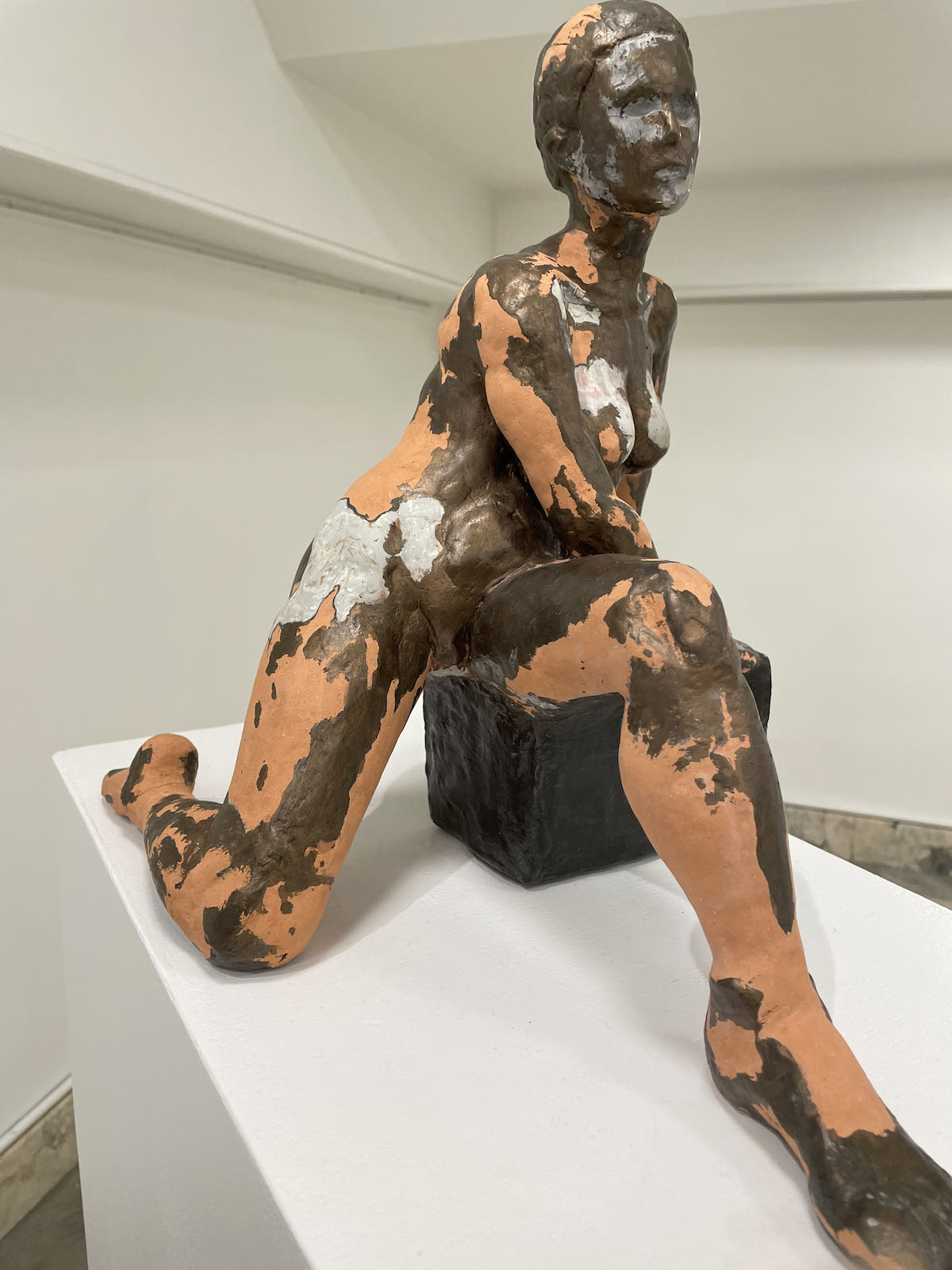
I believe the appeal to the Greek and Greek American communities is the story of two Greek-Americans. We were born 50 years apart (both Leos!) in Greece who came to New York at a young age and made art in this great city. But how the art differs!
What is your work seeking to convey?
I'm sharing my understanding of and my emotions about our fellow humans and of life. This is driven by my own interest in other people, in relationships with them, and (often) my inability to understand and connect with them. My self-portraits reflect my own challenges in life, and getting through them with some battering of the body and soul.
Because of the size of the space and the need to balance with the works of another artist, the works presented in the Consulate are smaller than my typical current work, for example the Hellenic Heads which are over lifesize heads that we will talk more about below.
You evolved into your artist life after many years in business. Why this transition? What inspired you?
I grew up in a family that was half artists (visual artists, musicians) and half business people. Even as a child it was clear to me that the life of the artist was not an easy one. Call it prescience, I hope we don't call it cowardice, after a liberal arts degree in 1985, I followed a business career. Then in 1996, the Muse beckoned and I started taking oil painting classes in the evenings and on weekends. I felt then as I do now that oil is not my medium! I looked for drawing classes and discovered that the New York Studio School, since its founding in the late 1950s, emphasizes drawing. Around 1998, I started with the Monday night drawing class and progressed to the famous Marathons under Graham Nickson: 10 days of drawing, some days more than 12 hours a day. At this point I have taken 6 or 7 marathons over two decades. So, NYSS has been my primary educational home for the last 20 years with side trips to the Art Students League and Academie de la Grande Chaumiere in Paris, where Giacometti, Bourgeois, Calder, Noguchi studied.
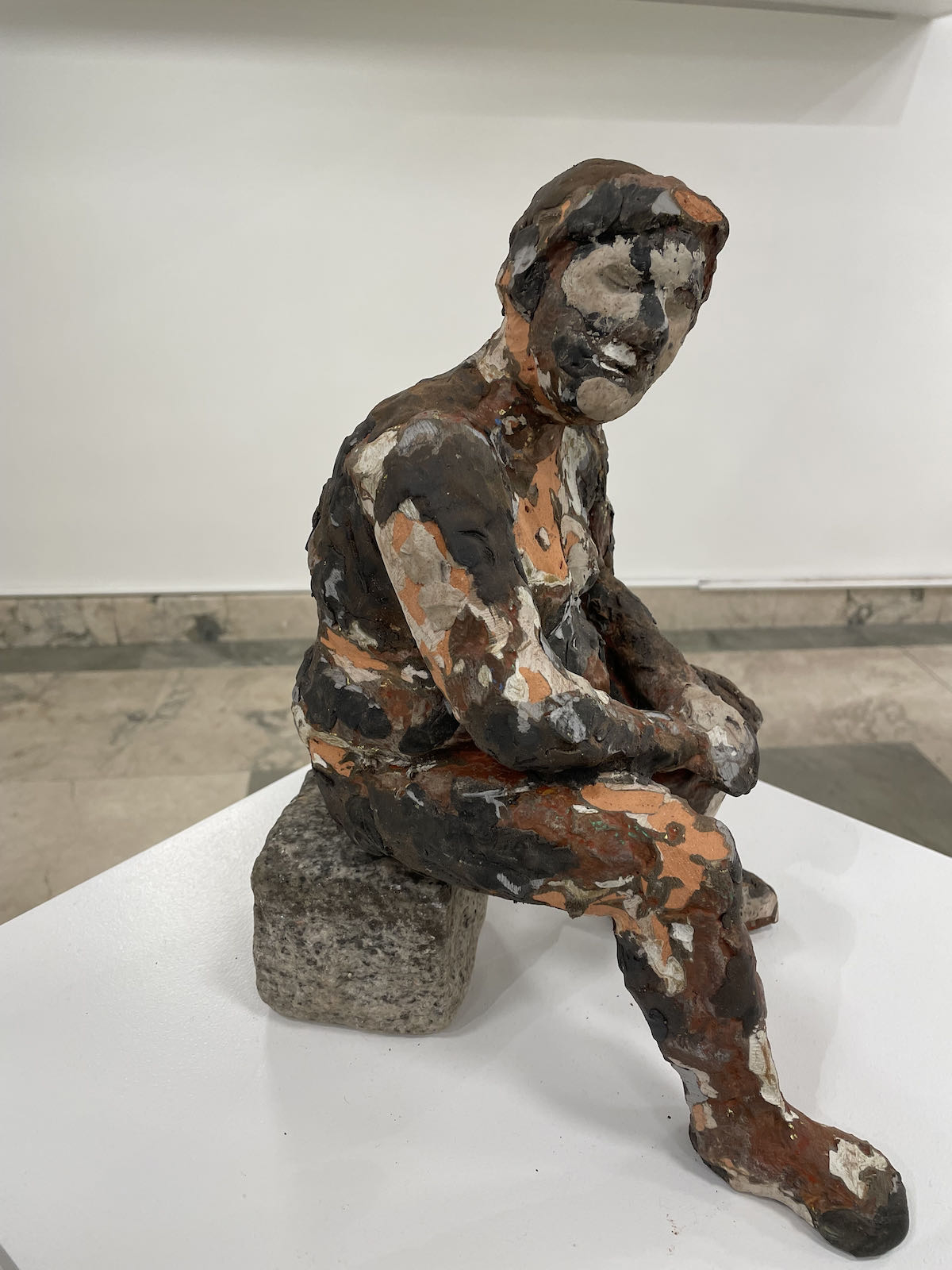
What moved you to go from part-time art student to full time working artist?
I had been flirting with the commitment to be a full time working artist for many years but every time I came close to "pulling the trigger"...I didn't. Then in 2017, I experienced multiple deaths of friends and family -- these caused me to evaluate what I wanted to do with my remaining years on this orb. In early 2018 I left for Paris to spend 5 weeks drawing and painting at La Grande Chaumiere and when I returned…I was fully committed.
How important is art history to you? How did you acquire your knowledge?
Art history is very important to me. Knowing about figurative sculpture from the Mesopotamians and Egyptians through to Charlie Ray and Huma Bhaba is critical -- not because I make copies but because I believe all the prior investigations into figurative sculpture are of real interest.
I built my art history knowledge over the decades, starting as a kid. From age 3 to 7 my family lived in New York City. In those early years I recall my mother and her sister, who grew up in worn-torn Greece in the 1930s to 1950s, going to every museum in New York dragging me along. Back in Greece from age 10, I would tag along with another aunt who gave tours of Greek antiquities -- museums, archaeological sites. Then in college, art history classes: discovering painting, the Renaissance through to the Modern movement. In my twenties, art trips to Paris, Florence, Rome. In more recent years, I'm continuously looking at contemporary sculpture especially figurative -- for example, Ray, Bhabha, Houseago, Altmejd stand out for me.
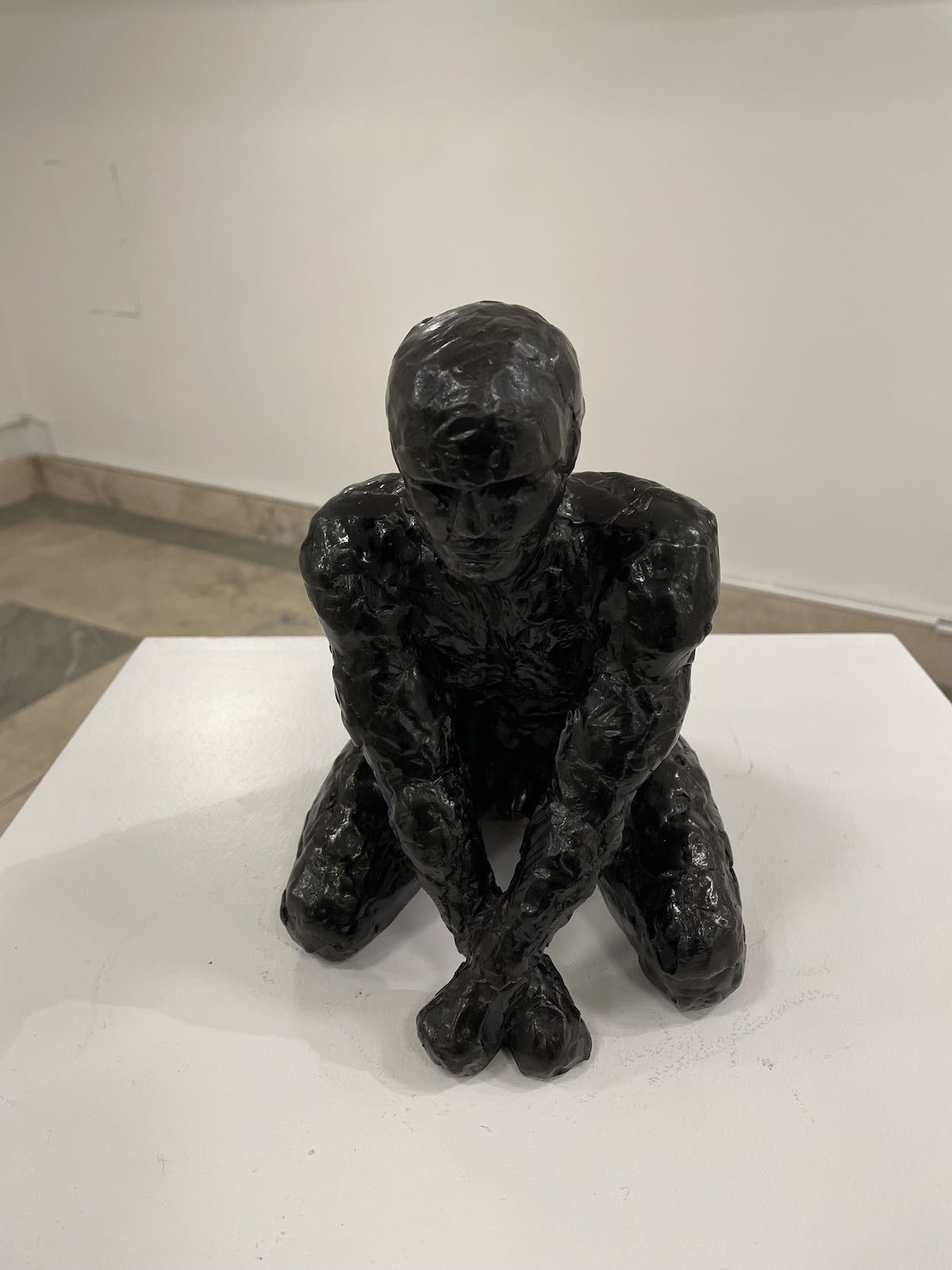
You have reworked the surfaces of the sculptures, imbuing them with an expressionistic surface of dabs of color. Such additions are delicately applied, not as glaze as in most ceramic sculptures. Discuss?
I start with clay -- often with a life model posing -- to get the basic form and build the volumes. I fire it and then start going to work on it with power tools to subtract volume and epoxy clays to add volume -- in doing so I create a variegated, often rough surface that I don't plan in advance, nor does it have a specific rationale. Often I add more materials including found bricks, stone and wood, and ferrous and copper based metals, paints and acids. Sometimes I like the patches of color and material to be tonal -- other times for the contrasts to be stronger which can make the form "disintegrate". This part of my process is indeed expressionistic, and I keep reworking the pieces until they seem "done" to me.
Have you thought of placing yourself in the context of the ceramic world? There is a long tradition of figurative ceramic work.
Indeed, there is wonderful ceramic figurative work; Rodin's early work for Carrier-Belleuse comes to mind, as does current sculptor Rachel Kneebone's porcelain work. Personally, I don’t think of myself as a ceramicist because clay is only a part of my process, often the part I spend the least time on. I don't use glazes at all.
The work has elements of the ancient and modern. Is it inspiration or influence or both?
Both! I find my work can be categorized in a few different ways. Some works are inspired by the ancient Greek great works -- my version isn't a copy, rather an interpretation, using a live model and contemporary materials and my own expressionistic rendering. Similarly I have works that are interpretations of 19th and 20th sculpture, such as Rodin, Malliol, the Greek great Yannoulis Chalepas. Third, and the largest category, are my works from my daily life: from professional models, portraits of family members and self portraits. Does my daily life work show classical influences? Possibly
I've seen some of your larger works, specifically the monumental heads which you call Hellenic Heads. Discuss?
The Hellenic Heads series is important for me on many levels. I have chosen 7 key periods in Greek history, from 500 BC to the present, and researched them. I have responded to each period with over lifesize heads, often using members of my family as models. This multi-year project has allowed me to understand what historical and cultural influences have shaped me and other Greeks and Greek Americans. I believe that for any civilization that has persisted and developed over 3,000 years, it is helpful -- necessary -- to know what came before in order to understand today’s psychology.
Some of the heads refer to ancient times, such as the Classical and Hellenistic periods. Others to Byzantium and later to the Greek revolution against the Ottoman empire, starting in 1821. Another head draws from the Greek and Armenian Genocide of 1922, which my grandmother survived. Another head refers to the decade of the 1940s in Greece, where I have reflected on the experiences of my parents and other family who lived through the Nazi occupation. To end on a lighter note, for the head of current times, my daughter was patient to pose for me, symbolizing hope for a better future.
Can you comment on how over lifesize heads relate to your small figures?
Like many sculptors, I prefer to work large. I have done one over-lifesize full figure (DEISIS) and I'm happy with it! But working at that scale is difficult and expensive. So I use smaller sizes, often in the range of 18 inches plus or minus, to work out ideas. I'm in good company with Rodin, whose clay work was often in that size range and from which enlargements were made.
As to the importance of scale: Jeff Koons has said that scale changes the way the viewer perceives the work, even if it is the exact same work simply enlarged. I see how people react to my monumental heads, which I make in clay a little larger than lifesize -- and then enlarge digitally to almost 3 times lifesize.
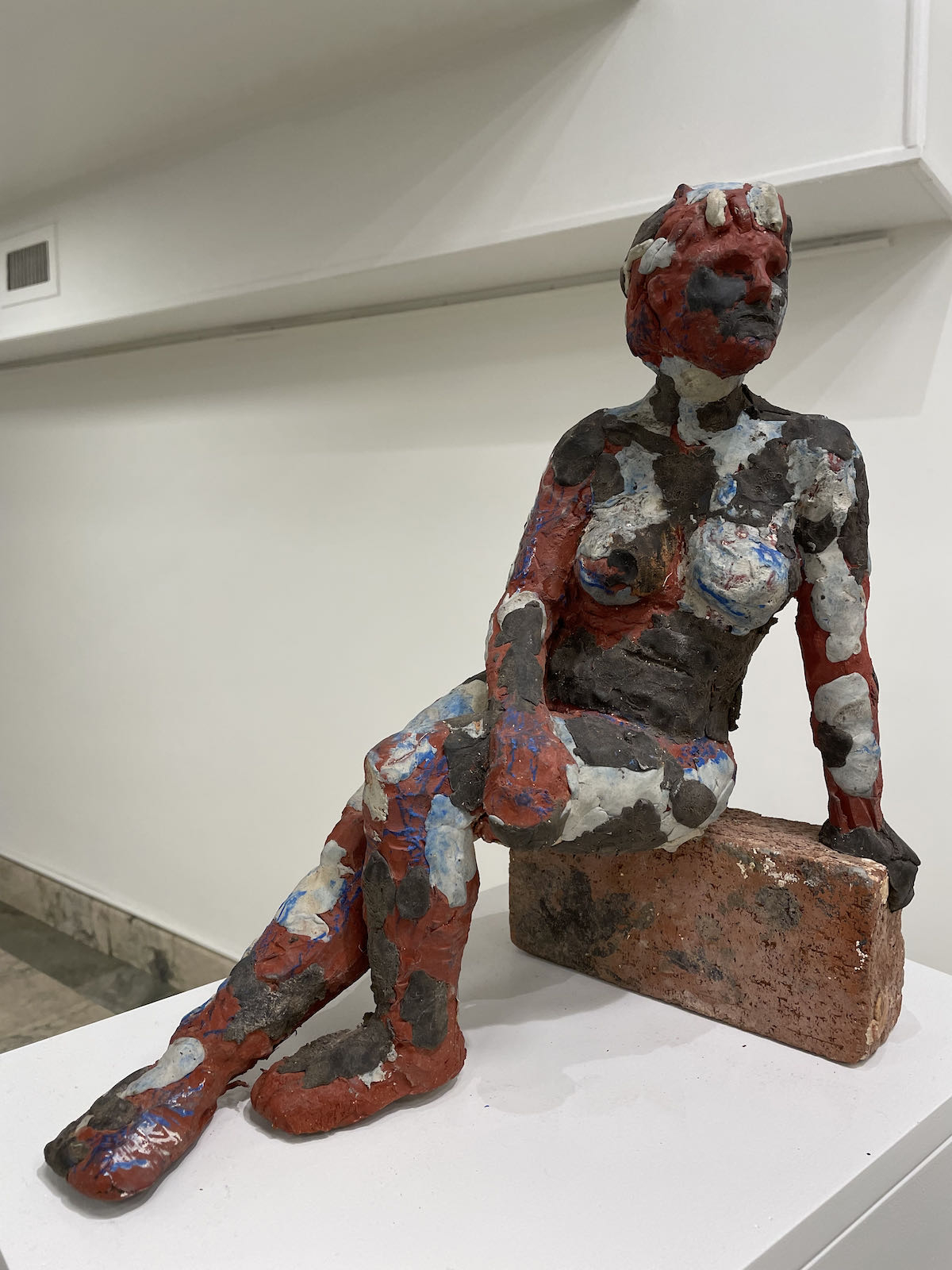
What are you working on now?
Completing the 7 Hellenic Heads! I showed three in 2021, in Mykonos, Monaco and Dubai (and I showed 1 in London). Now I have two more almost done, and starting on the last two, to have the whole series ready for 2022 shows.
Where are you showing after your current show in New York closes on Feb 3rd?
For the rest of 2022, I plan to show in Washington DC, Southampton and Los Angeles, with a side trip to Mykonos for my third solo show there. In 2023 I hope to show in European venues including my hometown of Athens Greece.
Many of today's most successful artists share two characteristics with you. One is that they are prolific. The other is that they have good business sense. Please comment.
I think you are right about successful artists I know of. As to being prolific, I have a workmanlike ethic: on the days that I go to the studio, I'm often there at 8 AM and if possible work for 12 hours with no more than a 45 minute lunch break. So, I produce a lot of work. As to business sense: my background has helped me with the non-art making aspects of being an artist, such as financial arrangements, legal agreements -- but perhaps more importantly it gives a state of mind of being efficient, setting goals, seeking results.

Thank you Kathleen, you did a great job and conveying what I'm doing and trying to do! Best wishes for 2022.